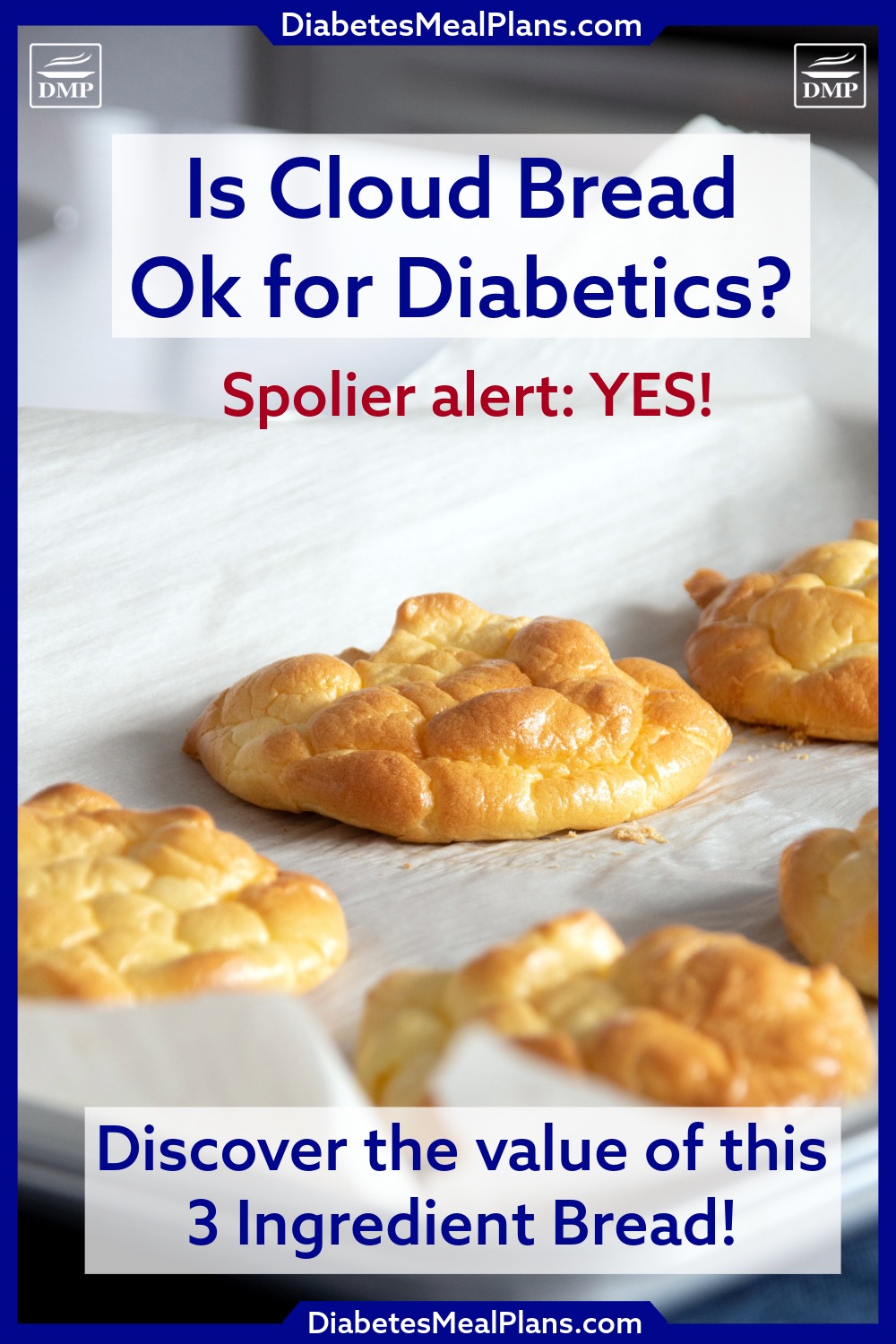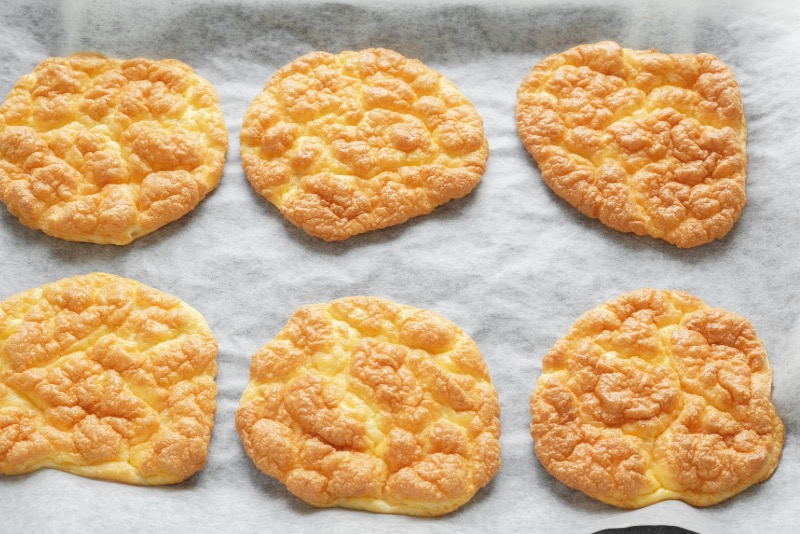Table of Contents[Hide][Show]
Cloud bread has gained significant attention as a low carbohydrate alternative to traditional bread.
When it comes to prediabetes or type 2 diabetes, it’s natural to wonder if this trendy bread aligns with blood sugar goals—especially with a name like ‘cloud.’
Here we’ll explore what cloud bread is, its nutritional profile, how it affects blood sugar levels, and whether it’s a good option for your diabetic diet plan.
What Is Cloud Bread?
Cloud bread, also known as oopsie bread, is a light and fluffy bread substitute made from a few simple ingredients: eggs, cream cheese or Greek yogurt, and a small amount of a stabilizing agent such as cream of tartar or baking powder. It gets its name from its airy texture, which resembles a cloud.
Plus, when cooked it looks a bit like a cloud as well!

Unlike traditional bread made with wheat flour, cloud bread contains no grains and is naturally gluten-free. The preparation involves whipping egg whites into stiff peaks to create volume and then folding them into the remaining ingredients before baking—we’ve got a recipe below.
Nutritional Profile of Cloud Bread
The exact nutritional content of cloud bread depends on the recipe, but here’s a general breakdown for one serving (one piece of cloud bread):
- Calories: 35–50
- Carbohydrates: <1 gram
- Protein: 2–3 grams
- Fat: 2–4 grams
- Fiber: 0 grams
- Sugar: <1 gram
Cloud bread is remarkably low in carbohydrates compared to traditional bread, which typically contains 12–20 grams of carbohydrates per slice.
This low carbohydrate content makes it appealing for diabetes, since you want to aim to minimize carbohydrate intake to optimize blood sugar levels.
How Cloud Bread Affects Blood Sugar
The impact of any food on blood sugar levels largely depends on its carbohydrate content, as carbohydrates are converted into glucose during digestion.
With less than one gram of carbohydrates per serving, cloud bread is unlikely to cause any significant spike in blood sugar.
Additionally, the protein and fat content in cloud bread can help slow digestion, leading to a more stable blood sugar response.
Benefits of Cloud Bread for Diabetics
- Low in Carbohydrates: Cloud bread is an excellent option for those following a low carbohydrate diet, which is the best diet to lower A1c. Quite simply, cloud bread has minimal carb content, which supports blood sugar stability.
- Versatile Substitute: Cloud bread can be used in various ways—as a sandwich base, a pizza crust, or even a replacement for burger buns. This versatility helps you enjoy favorite foods while staying within dietary goals.
- Gluten-Free Option: For people with both diabetes and gluten intolerance or sensitivity, cloud bread provides a safe, grain-free alternative.
- Simple Ingredients: With its short list of whole-food ingredients, cloud bread eliminates the additives and preservatives often found in commercial low carbohydrate bread options.

Are There Any Downsides to Cloud Bread?
While cloud bread has many benefits, there are a few considerations to keep in mind:
- Low in Fiber: Unlike whole-grain bread, cloud bread lacks fiber, which is essential for gut health and blood sugar regulation. Pairing it with fiber-rich foods such as vegetables or avocado can help balance your meal.
- Limited Nutrients: Cloud bread doesn’t provide the vitamins and minerals found in whole grains. It’s best used as part of a balanced diet that includes a variety of nutrient-dense foods.
- Taste and Texture Differences: The light, airy texture and mild flavor of cloud bread may not satisfy everyone. If you’re expecting it to mimic the dense, chewy texture of traditional bread, you might find it lacking.
Overall, unless you have the taste and texture, then these things aren’t deal breakers, as you’ll still be eating plenty of other healthy foods.
Homemade Cloud Bread Recipe
If you’re ready to give cloud bread a try, here’s a simple recipe you can make at home:
Ingredients:
- 3 large eggs, separated — you’ll be using the whites first, then the yolks (the most nutritious part of the egg!)
- 3 tablespoons cream cheese (softened) or full-fat Greek yogurt
- 1/4 teaspoon cream of tartar or 1/2 teaspoon baking powder
- Optional: Pinch of salt or seasoning (e.g., garlic powder, Italian herbs)
Instructions:
- Preheat your oven to 300°F (150°C) and line a baking sheet with parchment paper.
- In a mixing bowl, beat the egg whites and cream of tartar until stiff peaks form.
- In another bowl, mix the egg yolks and cream cheese (or yogurt) until smooth.
- Gently fold the egg whites into the yolk mixture until combined.
- Spoon the mixture onto the baking sheet, forming rounds about 3–4 inches in diameter (approximately 7 to 10 cm).
- Bake for 20–25 minutes or until golden brown. Cool before serving.

Baking Powder vs Cream of Tartar?
If you don’t have cream of tartar, baking powder is a common pantry item that works just as well.
Baking powder helps the batter hold its shape better during mixing and baking. It can add a bit of extra fluffiness to the final product, especially if your egg whites aren’t whipped perfectly.
If using baking powder, here’s how to adjust the preparation:
Prepare the Egg Whites: In a clean, dry bowl, beat the egg whites until foamy. Add the baking powder and continue beating on high speed until stiff peaks form. This will ensure your cloud bread is light and fluffy.
Mix the Egg Yolks and Cream Cheese/Yogurt: In a separate bowl, whisk the egg yolks with the cream cheese or yogurt until smooth. Add any desired seasoning or salt.
Combine the Mixtures: Gently fold the stiff egg whites into the yolk mixture. Be careful not to overmix, as this can deflate the batter.
Shape and Bake: Spoon the mixture onto the baking sheet to form rounds, leaving space between them. Bake for 20–25 minutes or until golden brown.
As you can see, both recipes are very similar.
Tips for Cloud Bread Success
- Use Fresh Baking Powder: Baking powder loses its effectiveness over time. Make sure yours is fresh for the best results.
- Combine Gently: When folding the egg whites into the yolk mixture, work slowly and carefully to preserve as much air as possible.
- Avoid Overmixing: Overmixing can deflate the batter, leading to a dense final product. Fold just until the ingredients are combined.
- Use the Right Amount: Stick to half a teaspoon of baking powder for this recipe. Too much can give the bread an unpleasant aftertaste.
- Test for Doneness: The cloud bread is done when the tops are golden brown, and they feel firm to the touch.
Is Cloud Bread a Good Option for Diabetics?
For people with diabetes, cloud bread can be a great alternative to traditional bread!
It’s low carbohydrates and will have minimal impact on blood sugar—what’s not to love about that.
So, what are you waiting for—give cloud bread a try.
Happy Baking!!

Leave a Reply